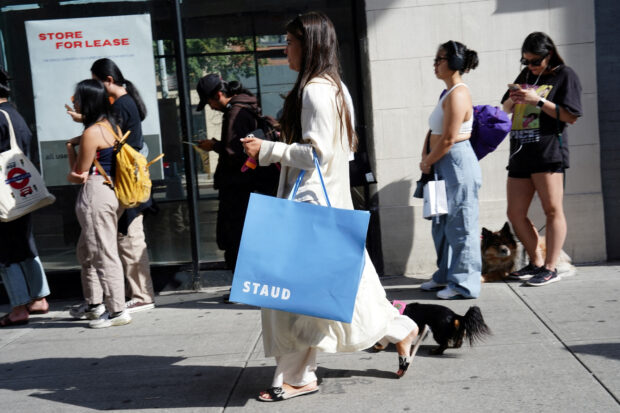US consumer prices unchanged; core inflation slowing

A woman carrying a shopping bag from Staud walks past people queuing for a pop-up shop in the SoHo neighborhood of New York City, U.S., Sept 21, 2023. REUTERS/Bing Guan/File photo
WASHINGTON -U.S. consumer prices were unchanged in October as Americans paid less for gasoline, and the annual increase in underlying inflation was the smallest in two years, bolstering views that the Federal Reserve was probably done raising interest rates.
Though rents continued to rise last month, the pace of increase slowed considerably from September. The softer-than-expected inflation readings reported by the Labor Department’s Bureau of Labor Statistics (BLS) on Tuesday pushed U.S. Treasury yields lower and ignited a rally on the stock market.
“The Fed always wants to see more progress but it is looking like the inflation battle has rounded the corner,” said Christopher Rupkey, chief economist at FWDBONDS. “With any luck, the economy will miss a recession and get lower inflation too.”
The unchanged reading in the consumer price index followed a 0.4-percent rise in September. Gasoline prices dropped 5 percent, offsetting the continued increase in the cost of rental accommodation. Prices at the pump rose 2.1 percent in September.
Food prices gained 0.3 percent after climbing 0.2 percent in each of the prior three months. Grocery food inflation increased 0.3 percent, driven by gains in the prices of meat, fish and eggs. Cereals and bakery products cost more, while fruit and vegetable prices were unchanged.
In the 12 months through October, the CPI climbed 3.2 percent after rising 3.7 percent in September.
Economists polled by Reuters had forecast the CPI gaining 0.1 percent on the month and increasing 3.3 percent on a year-on-year basis.
Though year-on-year consumer price rises have come down from a peak of 9.1 percent in June 2022, the disinflationary trend had stalled in recent months against the backdrop of a strong economy that is being powered by a relatively tight labor market. Inflation continues to run above the Fed’s 2 percent target.
Financial markets and most economists believe that the U.S. central bank’s monetary policy tightening campaign is over, a narrative that Fed Chair Jerome Powell and other policymakers have pushed back against. Powell said last week that “if it becomes appropriate to tighten policy further, we will not hesitate to do so.”
Since March 2022, the Fed has hiked its policy rate by 525 basis points to the current 5.25 percent-5.5 percent band.
U.S. Treasury prices rose, with the yield on the interest rate sensitive two-year note hitting a two-week low. The dollar fell against a basket of currencies. Stocks on Wall Street opened sharply higher.
Goods deflation
Excluding the volatile food and energy components, the CPI increased 0.2 percent amid higher costs for rental housing. The so-called core CPI had risen by 0.3 percent for two straight months.
The core CPI advanced 4 percent on a year-on-year basis in October, the smallest gain since September 2021, after increasing 4.1 percent in September.
Owners’ equivalent rent, a measure of the amount homeowners would pay to rent or would earn from renting their property, increased 0.4 percent after surging 0.6 percent in September. The cost of hotel and motel rooms declined 2.5 percent. Americans continued to pay more for motor vehicle insurance, whose prices accelerated 1.9 percent.
Recreation, personal care and apparel also cost more. But consumers got some relief from cheaper airline fares, household furnishings and operations. New motor vehicles cost slightly less as did communication services.
While prices for used cars and trucks declined for a fifth consecutive month, the pace of decrease slowed. Used cars and trucks have been the main driver of goods deflation.
Healthcare costs increased 0.3 percent, amid rises in prices for hospital services and prescription medication. Doctor visits cost less. Health insurance costs rebounded as the BLS implemented changes to the methodology it uses to calculate health insurance prices, effective with October’s CPI release.
The old method was based on an annual calculation using aggregated health insurance premium and benefit data. There were concerns about the volatility in the annual data and the lag involved in incorporating the health insurance financial data.
The new method introduces smoothing to the health insurance index to reduce the volatility and also incorporates semiannual financial data, which will shorten the lag in the index by six months. The BLS will update retained earnings every six months using half-year data and will calculate a two-year moving average to smooth the changes in retained earnings.